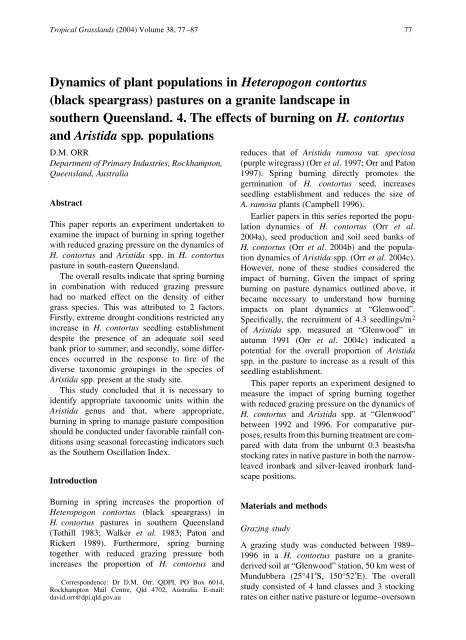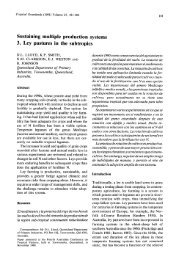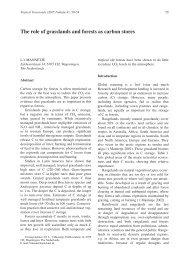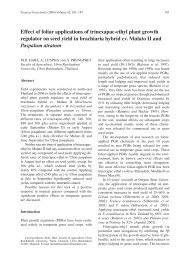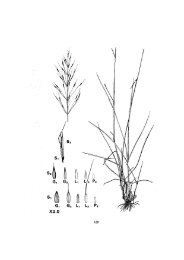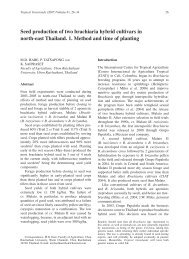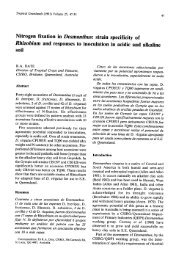Dynamics of plant populations in Heteropogon contortus - Tropical ...
Dynamics of plant populations in Heteropogon contortus - Tropical ...
Dynamics of plant populations in Heteropogon contortus - Tropical ...
Create successful ePaper yourself
Turn your PDF publications into a flip-book with our unique Google optimized e-Paper software.
<strong>Tropical</strong> Grasslands (2004) Volume 38, 77–87 77<br />
<strong>Dynamics</strong> <strong>of</strong> <strong>plant</strong> <strong>populations</strong> <strong>in</strong> <strong>Heteropogon</strong> <strong>contortus</strong><br />
(black speargrass) pastures on a granite landscape <strong>in</strong><br />
southern Queensland. 4. The effects <strong>of</strong> burn<strong>in</strong>g on H. <strong>contortus</strong><br />
and Aristida spp. <strong>populations</strong><br />
D.M. ORR<br />
Department <strong>of</strong> Primary Industries, Rockhampton,<br />
Queensland, Australia<br />
Abstract<br />
This paper reports an experiment undertaken to<br />
exam<strong>in</strong>e the impact <strong>of</strong> burn<strong>in</strong>g <strong>in</strong> spr<strong>in</strong>g together<br />
with reduced graz<strong>in</strong>g pressure on the dynamics <strong>of</strong><br />
H. <strong>contortus</strong> and Aristida spp. <strong>in</strong> H. <strong>contortus</strong><br />
pasture <strong>in</strong> south-eastern Queensland.<br />
The overall results <strong>in</strong>dicate that spr<strong>in</strong>g burn<strong>in</strong>g<br />
<strong>in</strong> comb<strong>in</strong>ation with reduced graz<strong>in</strong>g pressure<br />
had no marked effect on the density <strong>of</strong> either<br />
grass species. This was attributed to 2 factors.<br />
Firstly, extreme drought conditions restricted any<br />
<strong>in</strong>crease <strong>in</strong> H. <strong>contortus</strong> seedl<strong>in</strong>g establishment<br />
despite the presence <strong>of</strong> an adequate soil seed<br />
bank prior to summer; and secondly, some differences<br />
occurred <strong>in</strong> the response to fire <strong>of</strong> the<br />
diverse taxonomic group<strong>in</strong>gs <strong>in</strong> the species <strong>of</strong><br />
Aristida spp. present at the study site.<br />
This study concluded that it is necessary to<br />
identify appropriate taxonomic units with<strong>in</strong> the<br />
Aristida genus and that, where appropriate,<br />
burn<strong>in</strong>g <strong>in</strong> spr<strong>in</strong>g to manage pasture composition<br />
should be conducted under favorable ra<strong>in</strong>fall conditions<br />
us<strong>in</strong>g seasonal forecast<strong>in</strong>g <strong>in</strong>dicators such<br />
as the Southern Oscillation Index.<br />
Introduction<br />
reduces that <strong>of</strong> Aristida ramosa var. speciosa<br />
(purple wiregrass) (Orr et al. 1997; Orr and Paton<br />
1997). Spr<strong>in</strong>g burn<strong>in</strong>g directly promotes the<br />
germ<strong>in</strong>ation <strong>of</strong> H. <strong>contortus</strong> seed, <strong>in</strong>creases<br />
seedl<strong>in</strong>g establishment and reduces the size <strong>of</strong><br />
A. ramosa <strong>plant</strong>s (Campbell 1996).<br />
Earlier papers <strong>in</strong> this series reported the population<br />
dynamics <strong>of</strong> H. <strong>contortus</strong> (Orr et al.<br />
2004a), seed production and soil seed banks <strong>of</strong><br />
H. <strong>contortus</strong> (Orr et al. 2004b) and the population<br />
dynamics <strong>of</strong> Aristida spp. (Orr et al. 2004c).<br />
However, none <strong>of</strong> these studies considered the<br />
impact <strong>of</strong> burn<strong>in</strong>g. Given the impact <strong>of</strong> spr<strong>in</strong>g<br />
burn<strong>in</strong>g on pasture dynamics outl<strong>in</strong>ed above, it<br />
became necessary to understand how burn<strong>in</strong>g<br />
impacts on <strong>plant</strong> dynamics at “Glenwood”.<br />
Specifically, the recruitment <strong>of</strong> 4.3 seedl<strong>in</strong>gs/m 2<br />
<strong>of</strong> Aristida spp. measured at “Glenwood” <strong>in</strong><br />
autumn 1991 (Orr et al. 2004c) <strong>in</strong>dicated a<br />
potential for the overall proportion <strong>of</strong> Aristida<br />
spp. <strong>in</strong> the pasture to <strong>in</strong>crease as a result <strong>of</strong> this<br />
seedl<strong>in</strong>g establishment.<br />
This paper reports an experiment designed to<br />
measure the impact <strong>of</strong> spr<strong>in</strong>g burn<strong>in</strong>g together<br />
with reduced graz<strong>in</strong>g pressure on the dynamics <strong>of</strong><br />
H. <strong>contortus</strong> and Aristida spp. at “Glenwood”<br />
between 1992 and 1996. For comparative purposes,<br />
results from this burn<strong>in</strong>g treatment are compared<br />
with data from the unburnt 0.3 beasts/ha<br />
stock<strong>in</strong>g rates <strong>in</strong> native pasture <strong>in</strong> both the narrowleaved<br />
ironbark and silver-leaved ironbark landscape<br />
positions.<br />
Burn<strong>in</strong>g <strong>in</strong> spr<strong>in</strong>g <strong>in</strong>creases the proportion <strong>of</strong><br />
<strong>Heteropogon</strong> <strong>contortus</strong> (black speargrass) <strong>in</strong><br />
H. <strong>contortus</strong> pastures <strong>in</strong> southern Queensland<br />
(Tothill 1983; Walker et al. 1983; Paton and<br />
Rickert 1989). Furthermore, spr<strong>in</strong>g burn<strong>in</strong>g<br />
together with reduced graz<strong>in</strong>g pressure both<br />
<strong>in</strong>creases the proportion <strong>of</strong> H. <strong>contortus</strong> and<br />
Correspondence: Dr D.M. Orr, QDPI, PO Box 6014,<br />
Rockhampton Mail Centre, Qld 4702, Australia. E-mail:<br />
david.orr@dpi.qld.gov.au<br />
Materials and methods<br />
Graz<strong>in</strong>g study<br />
A graz<strong>in</strong>g study was conducted between 1989–<br />
1996 <strong>in</strong> a H. <strong>contortus</strong> pasture on a granitederived<br />
soil at “Glenwood” station, 50 km west <strong>of</strong><br />
Mundubbera (25°41′S, 150°52′E). The overall<br />
study consisted <strong>of</strong> 4 land classes and 3 stock<strong>in</strong>g<br />
rates on either native pasture or legume–oversown
78 D.M. Orr<br />
native pasture although the 3 earlier papers<br />
reported data from a subset <strong>in</strong>clud<strong>in</strong>g 2 land<br />
classes (narrow-leaved ironbark and silver-leaved<br />
ironbark) at 3 nom<strong>in</strong>al stock<strong>in</strong>g rates (0.3, 0.6 and<br />
0.9 beasts/ha) <strong>in</strong> both native pasture and legumeoversown<br />
native pasture. Further details <strong>of</strong> this<br />
graz<strong>in</strong>g study are provided <strong>in</strong> Orr et al. (2004a).<br />
Site and burn<strong>in</strong>g treatment<br />
Two additional paddocks, each 6.0 ha <strong>in</strong> size, were<br />
located <strong>in</strong> a mixed narrow-leaved ironbark/silverleaved<br />
ironbark landscape and were fenced dur<strong>in</strong>g<br />
w<strong>in</strong>ter 1992. Prior to the study reported here, the<br />
areas conta<strong>in</strong>ed <strong>in</strong> these 2 paddocks were parts <strong>of</strong><br />
additional areas with<strong>in</strong> the orig<strong>in</strong>al study<br />
described <strong>in</strong> Orr et al. (2004a) and, generally, had<br />
been grazed <strong>in</strong>termittently between 1989 and<br />
1992.<br />
One beast grazed each <strong>of</strong> these 2 additional<br />
paddocks (stock<strong>in</strong>g rate <strong>of</strong> 0.15 beasts/ha)<br />
between autumn 1992 and spr<strong>in</strong>g 1995 and the<br />
pastures were burnt each spr<strong>in</strong>g (1992–1995)<br />
follow<strong>in</strong>g the first ra<strong>in</strong>fall event greater than<br />
25 mm between August and November. After<br />
burn<strong>in</strong>g <strong>in</strong> spr<strong>in</strong>g 1995, the paddocks were stocked<br />
with 2 beasts (stock<strong>in</strong>g rate <strong>of</strong> 0.3 beasts/ha) until<br />
the study concluded <strong>in</strong> autumn 1996.<br />
Measurements<br />
Population changes. In each <strong>of</strong> the paddocks, 20<br />
permanent quadrats, each 0.5 × 0.5 m, were<br />
established <strong>in</strong> W<strong>in</strong>ter 1992 <strong>in</strong> 2 nests each <strong>of</strong> 10<br />
quadrats. Measurements <strong>in</strong> these quadrats were<br />
made <strong>in</strong>itially <strong>in</strong> W<strong>in</strong>ter 1992 and subsequently<br />
each autumn until 1996 us<strong>in</strong>g procedures outl<strong>in</strong>ed<br />
<strong>in</strong> Orr et al. (2004a). Briefly, the position <strong>of</strong><br />
<strong>in</strong>dividual H. <strong>contortus</strong> and Aristida spp. <strong>plant</strong>s<br />
<strong>in</strong> each quadrat was charted us<strong>in</strong>g a pantograph<br />
(Williams 1970) and the diameter measured<br />
firstly along the widest diameter and secondly the<br />
diameter <strong>in</strong> the perpendicular direction to this<br />
widest diameter.<br />
For the other 2 treatments, population data for<br />
both H. <strong>contortus</strong> and Aristida spp. were available<br />
for each year between 1990 and 1996. However,<br />
for the purposes <strong>of</strong> the comparisons<br />
reported here, data for the 1990, 1991 and 1992<br />
<strong>populations</strong> <strong>in</strong> each <strong>of</strong> these 4 paddocks were<br />
merged and these merged data were regarded as<br />
the orig<strong>in</strong>al population. By do<strong>in</strong>g this, all <strong>populations</strong><br />
had a common start<strong>in</strong>g time <strong>in</strong> 1992.<br />
Basal area <strong>of</strong> H. <strong>contortus</strong> and Aristida spp.<br />
Basal area <strong>of</strong> H. <strong>contortus</strong> and Aristida spp. was<br />
calculated on an <strong>in</strong>dividual quadrat basis as the<br />
sum <strong>of</strong> the areas occupied by <strong>in</strong>dividual <strong>plant</strong>s <strong>in</strong><br />
the quadrat while mean <strong>plant</strong> size was determ<strong>in</strong>ed<br />
as the total area divided by the number <strong>of</strong> <strong>plant</strong>s.<br />
(Further details are provided <strong>in</strong> Orr et al. 2004a;<br />
2004c.)<br />
Seed production <strong>of</strong> H. <strong>contortus</strong>. Seed production<br />
<strong>of</strong> H. <strong>contortus</strong> was calculated as the product <strong>of</strong><br />
<strong>in</strong>florescence density and seeds per <strong>in</strong>florescence.<br />
Briefly, <strong>in</strong>florescence density was measured annually<br />
<strong>in</strong> the permanent quadrats dur<strong>in</strong>g late March<br />
between 1993 and 1996. The number <strong>of</strong> seeds per<br />
<strong>in</strong>florescence was determ<strong>in</strong>ed annually from 5<br />
<strong>in</strong>florescences collected at random from each<br />
paddock. (Further details are provided <strong>in</strong> Orr et al<br />
2004b.)<br />
Soil seed bank <strong>of</strong> H. <strong>contortus</strong> and Aristida spp.<br />
The soil seed banks <strong>of</strong> H. <strong>contortus</strong> and Aristida<br />
spp. were estimated <strong>in</strong> spr<strong>in</strong>g each year between<br />
1992 and 1995 by germ<strong>in</strong>at<strong>in</strong>g seed conta<strong>in</strong>ed <strong>in</strong><br />
soil cores collected from the areas surround<strong>in</strong>g<br />
the permanent quadrats. Briefly, 4 cores, each<br />
5 cm diameter and 5 cm deep, were bulked to produce<br />
each sample and there were 15 samples (i.e.<br />
60 cores) from each paddock. In the subsequent<br />
summer, each sample was spread as a th<strong>in</strong> layer<br />
on top <strong>of</strong> sand <strong>in</strong> a 15 cm diameter dra<strong>in</strong>ed plastic<br />
pot and seed <strong>in</strong> these samples was germ<strong>in</strong>ated by<br />
water<strong>in</strong>g with an overhead spr<strong>in</strong>kler for 30 m<strong>in</strong>utes<br />
daily <strong>in</strong> a glasshouse (Orr et al. 1996). Seedl<strong>in</strong>gs<br />
were identified and counted after 6 weeks.<br />
(Further details are provided <strong>in</strong> Orr et al. 2004b).<br />
Data analysis<br />
Data were analysed by standard analysis <strong>of</strong><br />
variance as a completely randomised design with<br />
3 treatments and 2 replications. Plant survival<br />
was analysed us<strong>in</strong>g a proportional hazards survival<br />
model (Cox 1972).<br />
Results<br />
Seasonal conditions<br />
The overrid<strong>in</strong>g climatic condition throughout the<br />
study at “Glenwood” was drought with 6 consecutive<br />
years <strong>of</strong> below average ra<strong>in</strong>fall start<strong>in</strong>g <strong>in</strong>
Fire on <strong>Heteropogon</strong> <strong>contortus</strong> and Aristida spp. <strong>populations</strong> 79<br />
1990 (Figure 1). Overall, the site experienced<br />
moderate drought (395–441 mm received <strong>in</strong><br />
12 months) for 39 months and severe drought (less<br />
than 395 mm received <strong>in</strong> 12 months) for<br />
21 months as determ<strong>in</strong>ed by RAINMAN (Clewett<br />
et al. 1994). By 1993, the previous 4 consecutive<br />
grow<strong>in</strong>g seasons had been the driest s<strong>in</strong>ce district<br />
ra<strong>in</strong>fall records commenced <strong>in</strong> 1887. Furthermore,<br />
total ra<strong>in</strong>fall for the 5 years to June 1994 was the<br />
lowest for any cont<strong>in</strong>uous 5-year period. Thus, the<br />
results should be <strong>in</strong>terpreted accord<strong>in</strong>gly.<br />
Changes <strong>in</strong> <strong>plant</strong> density<br />
Plant density <strong>of</strong> H. <strong>contortus</strong> <strong>in</strong>creased after<br />
1993, particularly <strong>in</strong> the silver-leaved ironbark<br />
and burn<strong>in</strong>g treatments but overall there were no<br />
significant (P>0.05) differences between treatments<br />
or between years (Figure 2a). Plant density<br />
<strong>of</strong> Aristida spp. rema<strong>in</strong>ed unchanged between<br />
1992 and 1996 (Figure 2b).<br />
Seedl<strong>in</strong>g recruitment<br />
Large differences <strong>in</strong> recruitment <strong>of</strong> H. <strong>contortus</strong><br />
were apparent between years. With<strong>in</strong> years,<br />
recruitment was higher (P
80 D.M. Orr<br />
160<br />
Ra<strong>in</strong>fall<br />
Decile 5<br />
140<br />
120<br />
100<br />
80<br />
60<br />
Ra<strong>in</strong>fall (mm)<br />
40<br />
20<br />
0<br />
Aug-89<br />
Feb-90<br />
Aug-90<br />
Feb-91<br />
Aug-91<br />
Feb-92<br />
Aug-92<br />
Feb-93<br />
Aug-93<br />
Feb-94<br />
Aug-94<br />
Feb-95<br />
Aug-95<br />
Feb-96<br />
Time<br />
Figure 1. Monthly ra<strong>in</strong>fall recorded at “Glenwood” (bars) between August 1989 and February 1996 compared with Decile 5 ra<strong>in</strong>fall (cont<strong>in</strong>uous). Arrows (←→) <strong>in</strong>dicate times <strong>of</strong><br />
drought dur<strong>in</strong>g the experimental period as def<strong>in</strong>ed by RAINMAN (Clewett et al. 1994).
Fire on <strong>Heteropogon</strong> <strong>contortus</strong> and Aristida spp. <strong>populations</strong> 81<br />
(a)<br />
Density (<strong>plant</strong>s/m 2 )<br />
30<br />
25<br />
20<br />
15<br />
10<br />
5<br />
Narrow-leaved ironbark<br />
Silver-leaved ironbark<br />
Burn<strong>in</strong>g<br />
0<br />
1992 1993 1994 1995 1996<br />
(b)<br />
Density (<strong>plant</strong>s/m 2 )<br />
15<br />
12<br />
9<br />
6<br />
3<br />
Narrow-leaved ironbark<br />
Silver-leaved ironbark<br />
Burn<strong>in</strong>g<br />
0<br />
1992 1993 1994 1995 1996<br />
Figure 2. Changes <strong>in</strong> the density <strong>of</strong> (a) H. <strong>contortus</strong> and (b) Aristida spp. measured <strong>in</strong> autumn <strong>in</strong> unburnt narrow-leaved<br />
ironbark and silver-leaved ironbark pastures and a mixed pasture burned <strong>in</strong> spr<strong>in</strong>g <strong>in</strong> H. <strong>contortus</strong> pasture <strong>in</strong> southern<br />
Queensland.<br />
Aristida ramosa. In that research, fire stimulated<br />
the germ<strong>in</strong>ation <strong>of</strong> H. <strong>contortus</strong> seed (Campbell<br />
1996) and the subsequent seedl<strong>in</strong>g recruitment<br />
<strong>in</strong>creased both <strong>plant</strong> density and basal area (Orr<br />
et al. 1997). Furthermore, fire <strong>in</strong>itially reduced<br />
the size <strong>of</strong> <strong>in</strong>dividual <strong>plant</strong>s <strong>of</strong> A. ramosa and then<br />
resulted <strong>in</strong> their death (Orr et al. 1997). Neither <strong>of</strong><br />
these effects was recorded at “Glenwood”.<br />
Two explanations can be advanced for the<br />
different responses at “Glenwood” and Brian<br />
Pastures. Firstly, extreme drought conditions suppressed<br />
the expected response by H. <strong>contortus</strong> at<br />
“Glenwood”; and, secondly, there are taxonomic<br />
differences between the Aristida species present<br />
at “Glenwood” and the different species groups<br />
differ <strong>in</strong> their responses to fire.<br />
Extreme drought conditions throughout this<br />
study (Orr et al. 2004a) reduced seedl<strong>in</strong>g recruitment,<br />
despite the presence <strong>of</strong> adequate seed<br />
(Figure 5), compared with other fire studies <strong>in</strong><br />
this pasture type. For example, maximum seedl<strong>in</strong>g<br />
recruitment <strong>in</strong> autumn <strong>in</strong> the current study<br />
was 10 seedl<strong>in</strong>gs/m 2 <strong>in</strong> 1995 compared with<br />
20 seedl<strong>in</strong>gs/m 2 <strong>in</strong> autumn 1991 (Orr et al. 1997)<br />
at Brian Pastures and 150 seedl<strong>in</strong>gs/m 2 <strong>in</strong> autumn<br />
2000 <strong>in</strong> central Queensland (D.M. Orr, unpublished<br />
data), both recorded after “average”<br />
summer ra<strong>in</strong>fall. However, measur<strong>in</strong>g seedl<strong>in</strong>g<br />
recruitment <strong>in</strong> autumn, as occurred <strong>in</strong> the current<br />
study, fails to account for those seedl<strong>in</strong>gs which<br />
germ<strong>in</strong>ate over the summer but die before record<strong>in</strong>gs<br />
are made <strong>in</strong> autumn.
82 D.M. Orr<br />
Recruitment (seedl<strong>in</strong>gs/m 2 )<br />
(a)<br />
20<br />
15<br />
10<br />
5<br />
0<br />
Narrow-leaved ironbark<br />
Silver-leaved ironbark<br />
Burn<strong>in</strong>g<br />
1993 1994 1995 1996<br />
b<br />
b<br />
a<br />
Recruitment (seedl<strong>in</strong>gs/m 2 )<br />
(b)<br />
1<br />
0.75<br />
0.5<br />
0.25<br />
0<br />
Narrow-leaved ironbark<br />
Silver-leaved ironbark<br />
Burn<strong>in</strong>g<br />
1993 1994 1995 1996<br />
Figure 3. Changes <strong>in</strong> seedl<strong>in</strong>g recruitment <strong>of</strong> (a) H. <strong>contortus</strong> and (b) Aristida spp. measured <strong>in</strong> autumn <strong>in</strong> unburnt<br />
narrow-leaved ironbark and silver-leaved ironbark pastures and mixed pasture burned <strong>in</strong> spr<strong>in</strong>g <strong>in</strong> H. <strong>contortus</strong> pasture <strong>in</strong><br />
southern Queensland. With<strong>in</strong> years, columns with different letters are significantly (P
Fire on <strong>Heteropogon</strong> <strong>contortus</strong> and Aristida spp. <strong>populations</strong> 83<br />
Number <strong>of</strong> <strong>plant</strong>s (No/5m 2 )<br />
(a)<br />
60<br />
40<br />
20<br />
Narrow-leaved ironbark<br />
Silver-leaved ironbark<br />
Burn<strong>in</strong>g<br />
0<br />
1992 1993 1994 1995 1996<br />
Number <strong>of</strong> <strong>plant</strong>s (No/5m 2 )<br />
(b)<br />
60<br />
40<br />
20<br />
Narrow-leaved ironbark<br />
Silver-leaved ironbark<br />
Burn<strong>in</strong>g<br />
0<br />
1992 1993 1994 1995 1996<br />
Figure 4. Changes <strong>in</strong> the survival over time <strong>of</strong> (a) H. <strong>contortus</strong> and (b) Aristida spp. <strong>plant</strong>s <strong>in</strong> unburnt narrow-leaved<br />
ironbark and silver-leaved ironbark pastures and mixed pasture burned <strong>in</strong> spr<strong>in</strong>g <strong>in</strong> H. <strong>contortus</strong> pasture <strong>in</strong> southern<br />
Queensland.
84 D.M. Orr<br />
Seed production (seeds/m 2 )<br />
(a)<br />
8000<br />
6000<br />
4000<br />
2000<br />
0<br />
b<br />
a<br />
a<br />
b<br />
ab<br />
a<br />
Narrow-leaved ironbark<br />
Silver-leaved ironbark<br />
Burn<strong>in</strong>g<br />
1993 1994 1995 1996<br />
Seed bank (seeds/m 2 )<br />
(b)<br />
1200<br />
1000<br />
800<br />
600<br />
400<br />
200<br />
0<br />
Narrow-leaved ironbark<br />
Silver-leaved ironbark<br />
Burn<strong>in</strong>g<br />
1992 1993 1994 1995<br />
Figure 5. Changes <strong>in</strong> (a) seed production measured <strong>in</strong> autumn and (b) soil seed bank measured <strong>in</strong> spr<strong>in</strong>g <strong>of</strong> H. <strong>contortus</strong><br />
<strong>in</strong> unburnt narrow-leaved ironbark and silver-leaved ironbark pastures and mixed pasture burned <strong>in</strong> spr<strong>in</strong>g <strong>in</strong> H. <strong>contortus</strong><br />
pasture <strong>in</strong> southern Queensland. With<strong>in</strong> years, columns with different letters are significantly (P
Fire on <strong>Heteropogon</strong> <strong>contortus</strong> and Aristida spp. <strong>populations</strong> 85<br />
(a)<br />
4<br />
Narrow-leaved ironbark Silver-leaved ironbark Burn<strong>in</strong>g (B)<br />
(NLI)<br />
(SLI)<br />
Basal area (%)<br />
3<br />
2<br />
1<br />
B, SLI >NLI<br />
0<br />
1992 1993 1994 1995 1996<br />
(b)<br />
1.2<br />
1<br />
Basal area (%)<br />
0.8<br />
0.6<br />
0.4<br />
B, SLI >NLI<br />
B, SLI >NLI<br />
0.2<br />
0<br />
1992 1993 1994 1995 1996<br />
Figure 6. Changes <strong>in</strong> the basal area <strong>of</strong> (a) H. <strong>contortus</strong> and (b) Aristida spp. measured <strong>in</strong> autumn <strong>in</strong> unburnt narrowleaved<br />
ironbark and silver-leaved ironbark pastures and mixed pasture burned <strong>in</strong> spr<strong>in</strong>g <strong>in</strong> H. <strong>contortus</strong> pasture <strong>in</strong><br />
southern Queensland.<br />
severe drought precluded the <strong>in</strong>creased level <strong>of</strong><br />
seedl<strong>in</strong>g recruitment that could be expected. This<br />
f<strong>in</strong>d<strong>in</strong>g that low ra<strong>in</strong>fall was the major limitation<br />
to seedl<strong>in</strong>g recruitment contrasted, for example,<br />
with seedl<strong>in</strong>g recruitment studies <strong>of</strong> Themeda<br />
triandra (kangaroo grass) <strong>in</strong> southern Africa<br />
(O’Connor 1996), which <strong>in</strong>dicated that seed<br />
supply was the major limitation to recruitment.<br />
Implications for graz<strong>in</strong>g management<br />
Results presented here <strong>in</strong>dicate that burn<strong>in</strong>g<br />
H. <strong>contortus</strong> pastures <strong>in</strong> spr<strong>in</strong>g <strong>in</strong> comb<strong>in</strong>ation<br />
with reduced graz<strong>in</strong>g pressure does not always<br />
<strong>in</strong>crease the proportion <strong>of</strong> H. <strong>contortus</strong>. Some <strong>of</strong><br />
this failure was probably due to the lower than<br />
average ra<strong>in</strong>fall received throughout most <strong>of</strong> the<br />
study. Another factor may be that different taxa
86 D.M. Orr<br />
Area (cm 2 /<strong>plant</strong>)<br />
(a)<br />
175<br />
150<br />
125<br />
100<br />
75<br />
50<br />
25<br />
0<br />
1992 1993 1994 1995 1996<br />
(b)<br />
20<br />
15<br />
10<br />
5<br />
0<br />
B > SLI, NLI<br />
1994 1995 1996<br />
(c)<br />
2.5<br />
(d)<br />
60<br />
Area (cm 2 /<strong>plant</strong>)<br />
2.0<br />
1.5<br />
1.0<br />
0.5<br />
0.0<br />
1995 1996<br />
Figure 7. Changes <strong>in</strong> <strong>plant</strong> size <strong>of</strong> (a) orig<strong>in</strong>al <strong>plant</strong>s, (b) 1994 seedl<strong>in</strong>g cohort, and (c) 1995 seedl<strong>in</strong>g cohort <strong>of</strong> H. <strong>contortus</strong><br />
and (d) orig<strong>in</strong>al Aristida spp. <strong>plant</strong>s <strong>in</strong> unburnt narrow-leaved ironbark and silver-leaved ironbark pastures and mixed<br />
pasture burned <strong>in</strong> spr<strong>in</strong>g <strong>in</strong> H. <strong>contortus</strong> pasture <strong>in</strong> southern Queensland.<br />
40<br />
20<br />
0<br />
Narrow-leaved ironbark (NLI)<br />
Silver-leaved ironbark (SLI)<br />
Burn<strong>in</strong>g (B)<br />
1992 1993 1994 1995 1996<br />
with<strong>in</strong> the genus Aristida respond differently to<br />
burn<strong>in</strong>g.<br />
Acknowledgements<br />
Many people contributed to the sett<strong>in</strong>g up, overall<br />
conduct, data collection and analysis from this<br />
experiment. I particularly thank Mr D. McIvor,<br />
owner <strong>of</strong> “Glenwood”, for mak<strong>in</strong>g land and<br />
facilities available for this study and Mr J. Ogden<br />
who competently ma<strong>in</strong>ta<strong>in</strong>ed the experimental site<br />
throughout the study. I am grateful to Mr C. Paton<br />
for technical assistance.<br />
I thank colleagues <strong>in</strong> CSIRO and Department<br />
<strong>of</strong> Primary Industries for many useful discussions<br />
throughout the duration <strong>of</strong> this study and for<br />
assistance <strong>in</strong> data collection and <strong>in</strong>terpretation. I<br />
am grateful to Ms Christ<strong>in</strong>a Playford for statistical<br />
advice, Mr R. M. Jones for constructive criticism<br />
<strong>of</strong> a draft <strong>of</strong> this manuscript and Mr M. C. Yee who<br />
prepared the figures.<br />
This project (Project CS195) was supported by<br />
the Meat Research Corporation (now Meat and<br />
Livestock Australia).<br />
References<br />
CAMPBELL, S.D. (1996) Plant mechanisms that <strong>in</strong>fluence the<br />
balance between <strong>Heteropogon</strong> <strong>contortus</strong> and Aristida<br />
ramosa <strong>in</strong> spr<strong>in</strong>g burnt pastures. Ph. D. Thesis. University<br />
<strong>of</strong> Queensland.<br />
CLEWETT, J.F., CLARKSON, N.M., OWENS, D.T. and ABRECHT,<br />
D.G. (1994) Australian Ra<strong>in</strong>man: ra<strong>in</strong>fall <strong>in</strong>formation for<br />
better management. (Department <strong>of</strong> Primary Industries:<br />
Brisbane).<br />
COX, D.R. (1972) Regression and life tables. Journal <strong>of</strong> the<br />
Royal Statistical Society, Series B 34, 187–220.<br />
MCINTYRE, S. (1996) Susta<strong>in</strong>able and pr<strong>of</strong>itable native grasslegume<br />
pastures for southern speargrass lands. F<strong>in</strong>al Report,<br />
Meat Research Corporation, Sydney.<br />
MCINTYRE, S. and FILET, P.G. (1997) Choos<strong>in</strong>g appropriate<br />
taxonomic units for ecological survey and experimentation:<br />
the response <strong>of</strong> Aristida to management and landscape<br />
factors as an example. Rangelands Journal, 19, 26–39.<br />
MCKEON, G.M., DAY, K.A., HOWDEN, S.M., MOTT, J.J., ORR,<br />
D.M., SCATTINI, W.J. and WESTON, E.J. (1990) Northern<br />
Australian savannas: management for pastoral production.<br />
Journal <strong>of</strong> Biogeography, 17, 355–372.<br />
MENKE, N., MCKEON, G.M., HANSEN, V., QUIRK, M.F. and<br />
WILSON, B. (1999) Assess<strong>in</strong>g the climatic risk for Stylosanthes<br />
establishment <strong>in</strong> south-east Queensland. Proceed<strong>in</strong>gs<br />
<strong>of</strong> the VIth International Rangelands Congress, Townsville,<br />
1999. pp. 863–864.<br />
O’CONNOR, T.G. (1996) Hierarchical control over seedl<strong>in</strong>g<br />
recruitment <strong>of</strong> the bunch-grass Themeda triandra <strong>in</strong> a semiarid<br />
savanna. Journal <strong>of</strong> Applied Ecology, 33, 1094–1106.
Fire on <strong>Heteropogon</strong> <strong>contortus</strong> and Aristida spp. <strong>populations</strong> 87<br />
ORR, D.M., PATON C.J. and BLIGHT, G.W. (1996) An improved<br />
method for measur<strong>in</strong>g the germ<strong>in</strong>able soil seed banks <strong>of</strong><br />
tropical pastures. <strong>Tropical</strong> Grasslands, 30, 201–205.<br />
ORR, D.M. and PATON, C.J. (1997) Us<strong>in</strong>g fire to manage<br />
species composition <strong>in</strong> <strong>Heteropogon</strong> <strong>contortus</strong> (black speargrass)<br />
pastures. 2. Enhanc<strong>in</strong>g the effects <strong>of</strong> fire with graz<strong>in</strong>g<br />
management. Australian Journal <strong>of</strong> Agricultural Research,<br />
48, 803–810.<br />
ORR, D.M., PATON C.J. and LISLE, A.T. (1997) Us<strong>in</strong>g fire to<br />
manage species composition <strong>in</strong> <strong>Heteropogon</strong> <strong>contortus</strong><br />
(black speargrass) pastures. 1. Burn<strong>in</strong>g regimes. Australian<br />
Journal <strong>of</strong> Agricultural Research, 48, 795–802.<br />
ORR, D.M., PATON, C.J. and REID, D.J. (2004a) <strong>Dynamics</strong> <strong>of</strong><br />
<strong>plant</strong> <strong>populations</strong> <strong>in</strong> <strong>Heteropogon</strong> <strong>contortus</strong> (black speargrass)<br />
pastures on a granite landscape <strong>in</strong> southern Queensland.<br />
1. <strong>Dynamics</strong> <strong>of</strong> H. <strong>contortus</strong> <strong>populations</strong>. <strong>Tropical</strong><br />
Grasslands, 38, 17–30.<br />
ORR, D.M., PATON, C.J. and PLAYFORD, C. (2004b) <strong>Dynamics</strong><br />
<strong>of</strong> <strong>plant</strong> <strong>populations</strong> <strong>in</strong> <strong>Heteropogon</strong> <strong>contortus</strong> (black<br />
speargrass) pastures on a granite landscape <strong>in</strong> southern<br />
Queensland. 2. Seed production and soil seed banks <strong>of</strong><br />
H. <strong>contortus</strong>. <strong>Tropical</strong> Grasslands, 38, 31–41.<br />
ORR, D.M., PATON, C.J. and PLAYFORD, C. (2004c) <strong>Dynamics</strong><br />
<strong>of</strong> <strong>plant</strong> <strong>populations</strong> <strong>in</strong> <strong>Heteropogon</strong> <strong>contortus</strong> (black speargrass)<br />
pastures on a granite landscape <strong>in</strong> southern Queensland.<br />
3. <strong>Dynamics</strong> <strong>of</strong> Aristida spp. <strong>populations</strong>. <strong>Tropical</strong><br />
Grasslands, 38, 65–76.<br />
PATON, C.J. and RICKERT, K.G. (1989) Burn<strong>in</strong>g, then rest<strong>in</strong>g,<br />
reduces wiregrass (Aristida spp.). <strong>Tropical</strong> Grasslands, 23,<br />
211–218.<br />
TOTHILL, J.C. (1966) Phenological variation <strong>in</strong> <strong>Heteropogon</strong><br />
<strong>contortus</strong> and its relation to climate. Australian Journal <strong>of</strong><br />
Botany, 14, 35–47.<br />
TOTHILL, J.C. (1983) Fire <strong>in</strong> black speargrass (<strong>Heteropogon</strong><br />
<strong>contortus</strong>) pastures — a ten year comparison <strong>of</strong> burnt and<br />
unburnt treatments. In: Roberts, B. R. (ed.) The 2nd Queensland<br />
Fire Research Workshop Work<strong>in</strong>g Papers. (Darl<strong>in</strong>g<br />
Downs Institute: Toowoomba, Qld).<br />
WALKER, J., MALAFANT, K. and EDWARDS, J. (1983) The<br />
effects <strong>of</strong> fire on a Themeda-<strong>Heteropogon</strong> grassland near<br />
Rockhampton. In: Roberts, B. R. (ed.) The 2nd Queensland<br />
Fire Research Workshop Work<strong>in</strong>g Papers. (Darl<strong>in</strong>g Downs<br />
Institute: Toowoomba, Qld).<br />
WILLIAMS, O.B. (1970) Population dynamics <strong>of</strong> two perennial<br />
grasses <strong>in</strong> Australian semi-arid grassland. Journal <strong>of</strong> Ecology,<br />
58, 869–875.<br />
(Received for publication March 10, 2003; accepted November 30, 2003)


